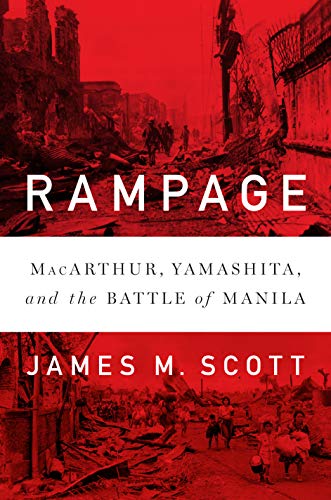Back when we were kids, we were taught in school how the U.S. saved us from the Japanese in 1945. We were never told anything about how Manila was obliterated during the so-called “liberation”, how more than a hundred thousand lives were sacrificed, and how useless it all was considering the fact that the Japanese Empire was about to surrender anytime soon.
Recently, the Los Ángeles Times published a book review written by Bob Drogin on a new book about the horrid consequences of World War II in Filipinas. Titled Rampage: MacArthur, Yamashita, and the Battle of Manila, the book in question “focuses in part on the 7,500 or so Americans and others held as prisoners of war or civilian internees in squalid conditions, and their dramatic rescue by U.S. troops”. While many books have already dealt with the subject, Drogin comments that author James M. Scott has added “a heart-rending portrayal of the brutal life” experienced by these POWs. Drogin also notes that the author has broken new ground “by mining war crimes records, after-action military reports and other primary sources for the agonizing testimony of Philippine survivors and witnesses of more than two dozen major Japanese atrocities during the battle — and the ferocious American response”.
To the Filipino history buff, the best part about this book is that Rampage is written not by a fellow Filipino but by a U.S. historian, in fact a 2016 Pulitzer Prize finalist. When the author comments in his book that “it was hard to tell who had done more damage — the Japanese defenders or the American liberators”, it would be difficult to accuse him of historical bias. Nevertheless, his confusion was already answered years ago by Nick Joaquín, the country’s premiere historian and 1976 National Artist for Literature. Joaquín had the privilege of interviewing several survivors of the Battle for Manila, leading him to conclude that it was both “Yank and Jap together that razed Intramuros”. Intramuros here, of course, meant “the original Manila“, the nerve center, the battlefield itself. But Joaquín’s mentioning of Intramuros should not mean that the Walled City’s suburbs (Ermita, Malate, etc.) were excluded from the useless U.S. rampage. As observed by a friend of mine, thousands of lives would not have been lost, and heritage buildings as well as other establishments would have been spared from destruction, had Gen. Douglas MacArthur simply waited for the Japanese to surrender after the bombing of Hiroshima and Nagasaki. It would have certainly led to that end, anyway.
Here’s an excerpt of Drogin’s book review:
It’s hard to imagine that a major month-long battle from World War II — one that devastated a large city, caused more than 100,000 civilian deaths and led to both a historic war crimes trial and a Supreme Court decision — should have escaped scrutiny until now.
But history has somehow overlooked the catastrophic battle for Manila, capital of the Philippines, in the waning months of the war. Like the Rape of Nanking, or the siege of Stalingrad, the tragedy of Manila deserves far greater understanding and reflection today.
James M. Scott remedies that gap with “Rampage: MacArthur, Yamashita, and the Battle of Manila,” the first comprehensive account of one of the darkest chapters of the Pacific War. It is powerful narrative history, one almost too painful to read in places but impossible to put down.
It begins as Gen. Douglas MacArthur, the egotistical military commander of the U.S. colony in the Philippines, was caught woefully unprepared when the war began. Japanese bombers destroyed his planes on the ground and American and Philippine forces were soon overwhelmed. MacArthur famously vowed to return as he was evacuated to Australia.
Three years later, the U.S. Navy had steadily clawed its way back across the Pacific and bombers were already striking Japanese industrial centers. Most commanders saw “no need to risk American lives on a costly invasion of the Philippines” when the fall of Japan appeared imminent, Scott writes.
Read the rest of the review here.

The ruins of Manila after a useless battle. Rampage: MacArthur, Yamashita, and the Battle of Manila can be ordered via amazon.com.


¿Quién era Lorenzo Guerrero y cuándo nació? ¿1904?
LikeLike
Hola Tía Isabel. Toda la información sobre Lorenzo Guerrero está aquí.
LikeLike